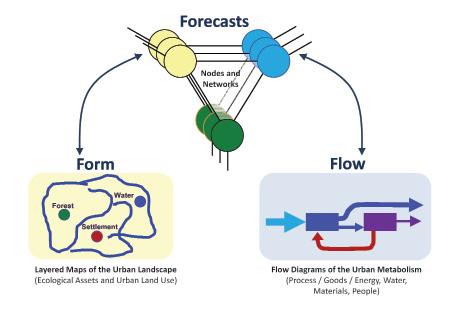
5 minute read
and Sustainability Box 1.3 Combining Flows and Forms to Create a Transdisciplinary Platform
BOX 1.3
Combining Flows and Forms to Create a Transdisciplinary Platform
Advertisement

This fl ow diagram summarizes all the water fl ow through Hong Kong (China) and is one of the fi rst illustrations of an urban metabolism.
Source: Boyden, Millar, and Newcombe (1981). Source: Copyright © ESRI, used by permission, http://www. esri.com/. Customers

Streets
Parcels
Elevation
Land Use
Real World
FLOWS: Material fl ow analysis and Sankey diagrams
Material fl ow analysis and Sankey diagrams are a method for calculating and illustrating the fl ow of resources through an urban area of any size. Inputs and outputs are determined as resources are extracted from nature; processed by infrastructure; consumed by homes and businesses; treated by infrastructure; and, fi nally, returned for reuse or delivered back to nature as waste. Colorful, but simple, diagrams are used to educate everyone on the resource fl ows and the effectiveness of their use, all on a single page.
FORMS: Layering of information on maps
Maps are especially useful in collaboration because they speak so well to so many. (A picture is worth a thousand words.) The layers of information make it possible immediately to interrelate the various features and qualities of the landscape and also easily to quantify important spatial relationships. Layering is an old technique that has become more powerful as a result of computer technology and satellite imagery.
INTEGRATING FORMS AND FLOWS: A transdisciplinary platform
Because diagrams and maps may be easily understood and shared by a broad range of professionals and decision makers, they help to bring stakeholders and experts together, facilitating a common understanding of integrated approaches to design and decision making. Forms and fl ows should be analyzed and understood for current and future scenarios. In combination, the methods represent a transdisciplinary platform for understanding the spatial dynamics of a city and its physical resource fl ows—elements that are interdependent, but diffi cult to integrate because they involve such different skills and stakeholders.

A platform is needed to integrate the design concepts for urban form with the corresponding resource fl ows.
Source: Redrawn and adapted from Baccini and Oswald (1998).
The Demand Versus Supply Approach
Urban infrastructure projects are predominately of a supply nature; that is, they are focused on the supply of a service rather than a reduction in the demand for a service. This may encourage the excessive use rather than the effi cient use of services, which is counter to sustainable development; for example, building more roads encourages a greater volume of traffi c. The approach to sustainable development should therefore involve reducing demand and then providing effi cient and effective supply.
Source: Lahti (2006).
investments. On the other hand, changes to existing buildings require collaboration among decision makers, and the benefi ts do not always accrue to those who must make the investments, thereby fracturing the incentive structure. For example, if owners cannot capture the benefi ts of energy effi ciency savings, they will not invest in retrofi tting; renters who have a short time horizon also have no incentive to invest in retrofi tting. In addition, the standards for products, including building codes, are often established by senior government entities and are therefore diffi cult to align with local goals and strategies. For all these reasons, a well-planned collaborative process is necessary if the benefi ts of integrating supply and demand are to be captured.
DSM measures may apply to all sectors and may include investments in more effi cient technology. Typical examples include energy retrofi ts of building envelopes; resource-effi cient lighting and appliances; low-fl ow water fi xtures; waste reduction, reuse, and recycling; and use of bus rapid transit instead of cars on the same roads (thereby avoiding the need to construct more roads). It may also imply a culture of doing more with less and living lightly on the Earth by voluntarily limiting consumption and waste. DSM may also be achieved by improving designs at multiple levels and through regular audits; commissioning, process enhancement; and improved training among the personnel who install, operate, and manage systems. The proliferation in the number of energy service companies (the end product of which is energy effi ciency) is evidence of the growing and still untapped potential of the energy effi ciency market.
Often, DSM in one sector may lead to benefi ts in another sector. For this reason, integrated approaches across sectors are critical. For instance, the signifi cant urban energy benefi ts of the water sector’s DSM led to a program launched by the Alliance to Save Energy. The program is called Watergy. The alliance has achieved signifi cant benefi ts in developingcountry cities by increasing access to clean water, while reducing energy costs and water losses. In Fortaleza (northeast Brazil), the alliance worked with the local utility, the Companhia de Água e Esgoto do Ceara, to develop and implement measures to improve the distribution of water and the access to sanitation services, while reducing operating costs and environmental impacts. The utility invested about US$1.1 million, including in the installation of an automatic control system, and saved US$2.5 million over four years. The effi ciency gains were so great that 88,000 new households were connected to the water system, without the need to increase supply (Barry 2007).
DSM can even apply to spatial systems. For example, the demand for land may be reduced through a review of regulations (including adjusting minimum lot sizes, increasing fl oor area ratios, revising zoning, and adjusting land subdivision parameters), layering of diff erent land use functions on the same site, or a reduction of parking spaces. (Additional analysis of the management of the spatial structure of cities may be found in part 3.) In all cases, the demand-supply relationship needs to be replaced with an approach that enables and encourages demand management.





